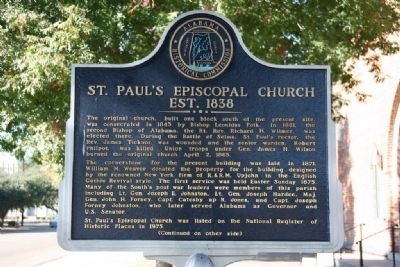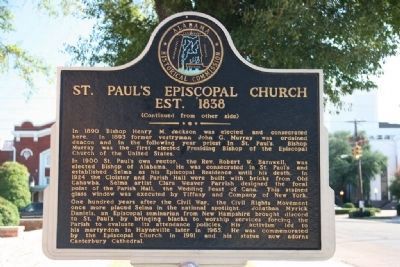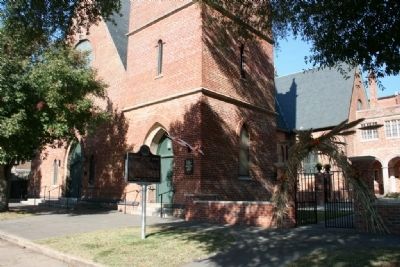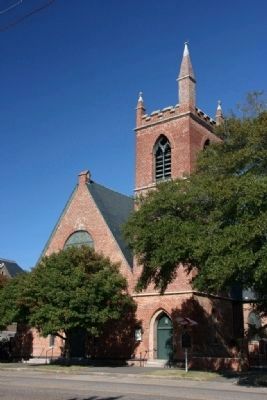Selma in Dallas County, Alabama — The American South (East South Central)
St. Paulís Episcopal Church Est. 1838
Inscription.
Side A
The original church, built one block south of the present site, was consecrated in 1843 by Bishop Leonidas Polk. In 1861, the second Bishop of Alabama, the Rt. Rev. Richard H. Wilmer, was elected there. During the Battle of Selma, St. Paulís rector, the Rev. James Ticknor, was wounded and the senior warden, Robert Philpot, was killed. Union troops under Gen. James H. Wilson burned the original church April 2, 1865.
The cornerstone for the present building was laid in 1871. William M. Weaver donated the property for the building designed by the renowned New York firm of R.&R.M. Upjohn in the English Gothic Revival style. The first service was held Easter Sunday 1875. Many of the Southís post war leaders were members of this parish including Lt. Gen. Joseph E Johnston, Lt. Gen Joseph Hardee, Maj. Gen. John H. Forney, Capt Catesby ap R. Jones, and Capt. Joseph Forney Johnston, who later served Alabama as Governor and U.S. Senator.
St. Paulís Episcopal Church was listed on the National Register of Historic Places in 1975.
Side B:
In 1890 Bishop Henry M. Jackson was elected and consecrated here. In 1893 former vestryman John G. Murray was ordained deacon and in the following year priest in St. Paulís. Bishop Murray was the first elected Presiding Bishop of the Episcopal Church of the United States.
In 1900 St. Paulís own rector, the Rev. Robert W. Barnwell, was elected Bishop of Alabama. He was consecrated in St. Paulís and established Selma as his Episcopal Residence until his death. In 1924 the Cloister and Parish Hall were built with bricks from Old Cahawba. Selma artist Clara Weaver Parrish designed the focal point of the Parish Hall, the Wedding Feast of Cana. This stained glass window was executed by Tiffany and Company of New York.
One hundred years after the Civil War, the Civil Rights Movement once more placed Selma in the national spotlight. Jonathan Myrick Daniels, an Episcopal seminarian from New Hampshire brought discord to St. Paulís by bringing blacks to worship services forcing the Parish to evaluate its attendance policies. His activism led to his martyrdom in Hayneville later in 1965. He was commemorated by the Episcopal Church in 1991 and his statue now adorns Canterbury Cathedral.
Erected by Alabama Historical Commission.
Topics and series. This historical marker is listed in these topic lists: Churches & Religion • Civil Rights • War, US Civil. In addition, it is included in the Alabama Historical Commission series list. A significant historical date for this entry is April 2, 1865.
Location. 32° 24.534′ N, 87° 1.305′
W. Marker is in Selma, Alabama, in Dallas County. Marker is at the intersection of Lauderdale Street and Selma Avenue, on the right when traveling north on Lauderdale Street. Touch for map. Marker is at or near this postal address: 10 North Lauderdale Street, Selma AL 36701, United States of America. Touch for directions.
Other nearby markers. At least 8 other markers are within walking distance of this marker. Votes for Women (within shouting distance of this marker); VII In. Brooke Rifle (about 400 feet away, measured in a direct line); Highlights of Selma History / William Rufus DeVane King 1786-1853 (about 400 feet away); Burning of Downtown (about 500 feet away); Lieutenant John Tillman Melvin (about 700 feet away); Federal Building and U.S. Court House (about 700 feet away); The Sleeping Prophet (approx. 0.2 miles away); Lee - Bender - Butler House (approx. 0.2 miles away). Touch for a list and map of all markers in Selma.
Credits. This page was last revised on June 16, 2016. It was originally submitted on November 7, 2010, by Timothy Carr of Birmingham, Alabama. This page has been viewed 1,553 times since then and 42 times this year. Last updated on November 7, 2010, by Timothy Carr of Birmingham, Alabama. Photos: 1, 2, 3, 4. submitted on November 7, 2010, by Timothy Carr of Birmingham, Alabama. • Bill Pfingsten was the editor who published this page.



